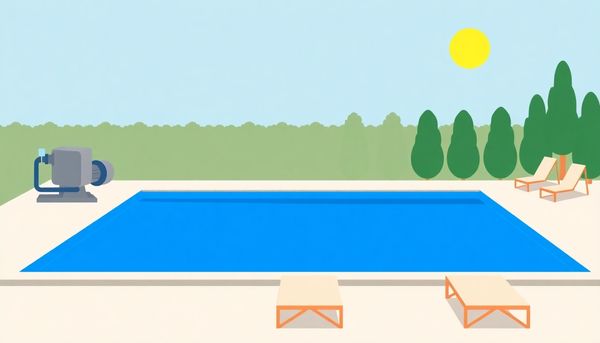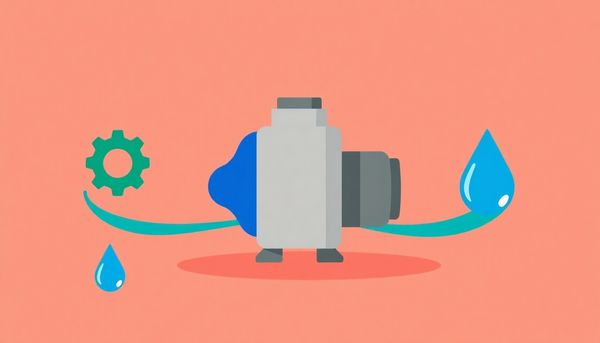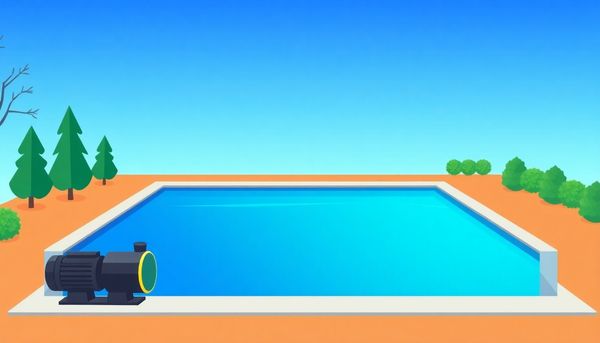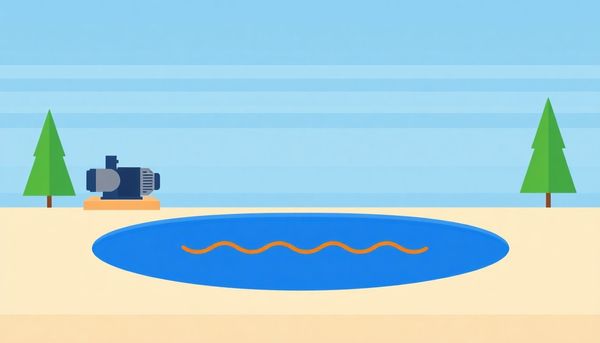2025 Pool Pump Guide: Choose the Best for Your Needs
October 19th, 2024
October 19th, 2024
Selecting the right pool pump in 2024 can feel like a daunting task, but it doesn’t have to be. A well-chosen pump can transform your pool from a stagnant basin to a crystal-clear oasis. Gone are the days when a single model fit all; today's market offers a wide array of options tailored to various needs and preferences. Whether you're a new pool owner or looking to upgrade your existing setup, understanding the nuances is crucial.
Consider last summer at my friend Sarah's house, where the pool was the centerpiece of every gathering. Her pump, however, was old and inefficient, leading to murky waters and frequent maintenance headaches. This year, armed with research and expert advice, Sarah opted for a variable-speed model. Not only did it reduce her energy bills, but it also drastically improved the water clarity, making her pool the prime spot for weekend relaxation.
In choosing the right pump, factors such as pool size, energy efficiency, and budget play a significant role. For instance, while energy-efficient pumps might have a higher initial cost, they often save money in the long run. Understanding these trade-offs is vital. By the end of this guide, you'll have the knowledge to make an informed decision, ensuring your pool remains a source of enjoyment, not frustration. Join me as we explore the essentials of finding the perfect pool pump tailored to your needs.

Selecting the perfect pool pump isn't just about grabbing the first one you see on sale. It requires understanding the nuances of different pump types and considering what suits your specific needs. Each pump type brings unique benefits and challenges, and recognizing these can save you from headache and expense down the line.
For those seeking classic simplicity, a single-speed pump may sound appealing, but do note that these are being phased out in many regions due to energy inefficiency. Their constant high-speed operation might have been the standard in yesteryears, but today's energy-conscious consumers are leaning more towards alternatives.
Dual-speed pumps offer a step up, providing versatility with both high and low-speed settings. This can be particularly advantageous for varying demands, such as when you need a quick turnover of water after a pool party or wish to conserve energy during routine cleaning. However, the efficiency gains are somewhat limited compared to their advanced counterparts.
Enter the variable-speed pump, the crown jewel for most pool owners. Equipped with a magnet motor—similar to those in electric vehicles—these pumps adjust their speed to match the pool's needs, conserving energy and cutting down on operating costs. Despite a higher initial investment, they often qualify for utility rebates and significantly reduce electricity bills. Moreover, their whisper-quiet operation ensures that your pool remains a tranquil oasis rather than a bustling construction site.
Ultimately, the choice boils down to understanding your pool's requirements and balancing them with your budget and environmental considerations. Whether you opt for flexibility, efficiency, or a blend of both, selecting the right pump type is a keystone in crafting a sustainable and enjoyable swimming experience.
Peering into the world of pool pumps might seem like uncharted waters, but understanding their components is your first step towards mastering your aquatic oasis. At the core of every pool pump lies a trio of crucial elements: the housing, the impeller, and the motor. Each plays a vital role in ensuring your pool remains a sparkling retreat rather than a stagnant pond.
Begin with the housing, often resembling a robust container that cradles your pool's lifeblood. This compartment, equipped with a basket and a transparent lid, draws in water and sifts out debris before it reaches the filter. It's like your pool's first line of defense, preserving the delicate balance of clean and dirty.
Next, the impeller steps into the spotlight. Imagine a high-speed whirlwind that doesn't merely spin for show. This inverted blade spins rapidly, creating the suction needed to propel water through the system. Its efficiency dictates how well your pool water circulates, directly impacting the health of your pool environment.
Lastly, there's the motor, the powerhouse behind the operation. This component is tasked solely with driving the impeller, akin to an engine in a car. Understanding its capabilities—whether single-speed, dual-speed, or variable-speed—helps you make informed decisions about energy efficiency and performance.
Remember, recognizing these components not only aids in selecting the right pump but also empowers you to troubleshoot with confidence when challenges arise. Embrace this knowledge, and your pool will remain a shimmering sanctuary for years to come.
Selecting the right pool pump in 2024 is not just about horsepower or compatibility; it's also about energy efficiency, a crucial factor given rising electricity costs and environmental concerns. Consider a friend's experience: after installing a sleek, variable-speed pump, she noticed her energy bills dropped significantly, while her pool remained pristine. That's the impact of energy-efficient options.
Variable-speed pumps are the champions in this arena. Unlike their single-speed or dual-speed counterparts, they allow you to adjust the flow rate, consuming only the energy necessary for each task. It’s akin to driving a car that seamlessly shifts gears based on speed: you save fuel and reduce wear. Moreover, these pumps often come with programmable settings, letting you fine-tune their operation to your pool’s unique needs.
Don't overlook the potential for rebates. Many utility companies offer financial incentives for switching to energy-efficient models, easing the initial investment. While a variable-speed unit may have a higher upfront cost, the savings in energy and potential rebates can make it a wise long-term investment.
As you evaluate these options, remember that an energy-efficient pump is not just a purchase; it's a step towards a more sustainable and cost-effective pool management strategy. Embrace this opportunity to enhance your pool's efficiency while reducing your carbon footprint.
Selecting the right pool pump starts with understanding the unique demands of your pool type. Imagine you’re hosting a summer barbecue, and your above-ground pool is the star attraction. The gentle hum of the right pump ensures the water remains crystal clear, impressing your guests. Above-ground pools typically require a pump with lower horsepower—often between 0.5 to 1 HP—designed to handle smaller volumes without overwhelming the filtration system.
Conversely, inground pools often present a different set of challenges. With their larger size and more complex plumbing systems, an inground pool benefits from a pump that can manage greater water pressure and volume. Here, a dual-speed or variable-speed pump might shine, providing energy efficiency alongside flexibility in water turnover rates. These pumps, with their advanced motors, adjust to your pool's needs, ensuring optimal performance while saving on energy costs.
Consider your pool's specific design elements, too. For instance, a pool with integrated water features or a spa might need a pump that can handle additional hydraulic demands. In such cases, investing in a variable-speed pump not only improves efficiency but also enhances the overall swimming experience.
Ultimately, matching your pump to your pool type involves more than just size or horsepower. It’s about harmonizing with your pool's unique characteristics and ensuring the longevity of your aquatic oasis.

The hum of a good pool pump is like a symphony to an aquatics enthusiast—a sign of water in constant, cleansing motion. To appreciate this marvel, one must delve into the mechanics that drive it. Think of the pool pump as a diligent worker, tirelessly filtering impurities and keeping the water crystal clear. This unit is composed of three main components: the housing, the impeller, and the motor, each playing a vital role in the circulation process.
Starting with the housing, it’s akin to the pump's shell. This part encases the essential components, featuring a bucket and basket system designed to catch debris before water reaches the impeller. The clear lid is not just functional but also provides a window into the pump's inner workings, allowing for easy monitoring of the basket's contents.
Then there's the impeller, a high-speed spinning blade that propels water through the system. Its efficient design is what ensures that debris-free water is pushed onward to the filtration unit, maintaining the pool’s hygiene.
Lastly, the motor. Often the unsung hero, it powers the impeller, setting the entire process in motion. Motors in modern variable-speed pumps use permanent magnet technology, echoing the efficiency of electric vehicles by reducing friction and boosting energy savings.
Understanding these mechanics not only helps in selecting the right pump but also empowers you to troubleshoot minor issues before they cascade into major headaches. It’s your pool’s circulatory system, and knowing how it all works is the key to a healthy, inviting swim.
Understanding the intricacies of pool pump components is like unraveling the mysteries of a mechanical symphony. At the core of this ensemble, the housing plays the role of conductor. Comprising a bucket and basket enclosed by a clear lid, it ushers pool water into the system, filtering out large debris before the water journeys onward. This simple yet vital process sets the stage for sparkling clean water.
Next in the lineup is the impeller, a high-speed, inverted blade that dances with centrifugal force. Imagine it as the whirlwind driving water through the system. As it whirls, it creates the necessary suction to propel water from the pool, through the filter, and back again, ensuring contaminants are effectively caught.
Completing the trio is the motor, the literal powerhouse of the pump. Its sole mission is to spin the impeller, influencing how efficiently the pump operates. Whether it's a single-speed, dual-speed, or variable-speed motor, choices abound, each offering different levels of energy efficiency and operational noise. My friend recently swapped their single-speed motor for a variable-speed one and noticed an immediate drop in energy bills and a much quieter backyard.
Understanding these components not only helps in selecting the right pump but also prepares you for troubleshooting or upgrading decisions. As you navigate the pool pump market in 2024, this knowledge will be your most valuable tool in ensuring your pool remains a pristine oasis.
In the world of pool maintenance, selecting the right pump type is akin to choosing the perfect engine for a car. The decision impacts not just performance, but also efficiency and cost over time. The choice among pumps might seem overwhelming, but understanding the basics can simplify the process significantly.
First, consider the single-speed pool pump, the traditional workhorse found in many backyards. Its single-speed operation is straightforward but not particularly energy-efficient. If your state allows its installation, it could be an affordable option, though its higher energy consumption might lead to increased utility bills.
A step up is the dual-speed pump, offering a balance between performance and efficiency. With high and low settings, it adapts to different needs, ideal for those looking to save on energy without sacrificing too much power. Think of it as a versatile option that provides more control over your pool's operations.
Finally, the variable-speed pump is the crème de la crème of pool technology. Equipped with a permanent magnet motor, these pumps offer unrivaled efficiency and quiet operation. Although the initial cost is higher, the long-term savings on energy bills make it a wise investment. In fact, many utility companies offer rebates for installing variable-speed pumps, sweetening the deal with tangible financial incentives.
Choosing the right pump involves considering your pool's specific needs, local regulations, and your budget. Whether it’s a single-, dual-, or variable-speed pump, each type has its merits. Weighing these options carefully ensures your pool remains a clean, tranquil oasis all season long.
When your pool pump decides to throw a tantrum, it often doesn't do so quietly. These machines are the unsung heroes of pool maintenance, and keeping them running smoothly is crucial. A pool pump that protests with loud noises, leaks, or refuses to start can transform a backyard oasis into a potential headache. But fear not—most issues are common and can be resolved with a bit of troubleshooting.
A persistent leak may often point to a worn-out O-ring or a bad shaft seal. These components are relatively easy to replace, sparing you the cost of professional intervention. Spotting the exact source of the leak can sometimes feel like solving a mystery, but once the culprit is found, you can swiftly return your pump to its watertight glory.
Another hiccup is when the pump fails to pull water. This can result from a clogged skimmer or a blocked impeller. A quick inspection of these areas might reveal leaves or debris as the guilty parties. Clearing them can restore your system’s efficiency. If the problem persists, an air leak in the suction line might be to blame. In such cases, examining the lines for leaks and sealing any gaps usually does the trick.
Sometimes, a pump that refuses to start can be traced back to an electrical issue. Check the breaker first; if it isn't tripped, there might be a deeper electrical problem that needs attention. For issues beyond your comfort zone, calling a professional might be wise—keeping your fingers safe and your pool clean.
With a bit of diligence and a willingness to get your hands wet, most pool pump problems can be tackled head-on. Keeping your pump in check isn't just about maintaining your pool; it’s about preserving that slice of summer paradise every day.

In today's world, the quest for energy efficiency isn't just a trend—it's a responsibility and a savvy financial decision. When it comes to pool pumps, upgrading for energy efficiency can save both the planet and your pocketbook. My friend recently decided to swap out his old single-speed pump for a new variable-speed model, and the difference was astounding.
These modern marvels, like the ones using a permanent magnet motor, are engineered for optimal performance with minimal energy consumption. Unlike their single-speed predecessors that guzzle electricity, variable-speed pumps adjust their flow rates to match your pool's specific needs. They can run at lower speeds for longer periods, ensuring effective filtration while consuming less power. Imagine cutting your energy bills by as much as 70%—a figure not to be taken lightly when considering year-round operation.
But savings don't stop at electricity. Some regions offer utility rebates for homeowners who choose energy-efficient appliances, making the initial investment even more appealing. A quiet operation is an added bonus; these pumps often run at lower decibels, transforming your backyard from a noisy hub to a serene oasis.
Before you take the plunge, make sure to check local regulations and consider your pool's unique requirements. With the right energy-efficient pump, you're not only investing in your pool's future—you're making a smart, sustainable choice for your home.
Selecting the right pool pump is akin to choosing the best pair of running shoes—it's all about fit, efficiency, and meeting your specific needs. The first step in this journey is understanding the different types of pumps available on the market: single-speed, dual-speed, and variable-speed.
Single-speed pumps are the classic players in the field. They operate at a constant rate, like a marathon runner maintaining a steady pace. However, they tend to be energy-intensive, which might not suit modern eco-conscious needs or state regulations—several states have banned new installations of these pumps.
Stepping up the game, dual-speed pumps offer more flexibility. They provide the option to switch between high and low speeds, much like adjusting your treadmill's incline for a bit more efficiency. While the high speed mimics the performance of a single-speed pump, the lower setting conserves energy, though it may not always deliver the most efficient water turnover.
Finally, variable-speed pumps. These are the high-tech sneakers in the pool world, equipped with advanced motors similar to those found in electric cars. They allow for precise control over the pump's speed, optimizing energy use and minimizing noise. Plus, they're often eligible for utility rebates, which might be a worthwhile investment in the long run.
Ultimately, your choice should reflect the size of your pool, your energy goals, and local regulations. A variable-speed pump may come with a higher price tag, but its long-term savings and environmental benefits make it a compelling option for many pool owners.
Finding ways to cut back on energy costs can feel like a game of financial hide-and-seek, but when it comes to pool pumps, strategic choices can lead to significant savings. Venturing beyond the traditional single-speed pump opens up a world of energy efficiency that promises both ecological and economic benefits.
Consider the variable-speed pump, an upgrade that many pool owners are adopting. Unlike its single-speed predecessor, a variable-speed pump allows you to adjust the speed to match your pool's specific needs. By running at a lower speed for routine filtration, you save considerable energy. For example, my neighbor swapped to a variable-speed model last summer and saw a noticeable dip in his monthly electricity bill—enough to fund a small family barbecue every month!
Meanwhile, dual-speed pumps offer a middle ground, operating at a high speed for tasks like vacuuming, and a lower, more energy-efficient speed for regular circulation. This duality helps to balance performance with energy consumption, making it an attractive option for pools with varying needs.
Keep in mind that certain states have regulations prohibiting the installation of single-speed pumps, urging the shift toward more efficient models. This transition is not only a nod to sustainability but also a savvy financial decision. As energy costs continue to rise, investing in an efficient pool pump can help keep those summer swims from soaking your wallet.
Every pool owner knows the sinking feeling when their pump starts acting up. That trusty device, which once buzzed quietly in the background, is now making mysterious sounds or, worse, has stopped altogether. Understanding common pump issues can save you a heap of trouble and expenses.
First, let’s tackle leaks. These pesky drips often stem from worn-out O-rings or shaft seals. A personal tip: keep a maintenance kit handy. These kits usually contain replacement rings and seals, saving you a trip to the store when a leak starts.
If your pump isn't pulling water effectively, it might be due to a blockage in the system. Debris often clogs the skimmer or pump baskets. Once, I found a small toy lodged in a neighbor's pump, causing all sorts of havoc. Ensuring these components are clear can restore proper water flow.
For pumps that won’t start, inspect the circuit breaker first. A tripped breaker is a quick fix. However, if the breaker’s fine, the issue may lie with the motor itself. Electrical problems demand caution—sometimes, calling a professional is the safest bet.
Lastly, unusual noises can signal cavitation or failing bearings. Cavitation occurs when the pump isn't getting enough water; ensuring there are no air leaks in the intake can help. Meanwhile, squealing bearings need replacement, as ignoring them could lead to motor damage.
In a nutshell, a little troubleshooting know-how keeps your pump—and your pool—running smoothly.

Choosing the right pool pump for your setup can seem like decoding a puzzle, but it's all about balance. Start by assessing your pool’s specific needs. If your pool boasts intricate water features like waterfalls or fountains, a variable-speed pump might be your best bet. These models offer versatile speed settings, allowing them to handle varying flow requirements efficiently without guzzling too much energy. On the other hand, simpler pools might fare well with a dual-speed pump. They offer flexibility and energy savings over single-speed models, adapting to different operational needs while keeping the utility bills in check.
Consider the layout of your pool’s plumbing system, too. A pump's horsepower must complement the size of your filter and pipework. Installing a pump with excessive horsepower can strain your system, leading to premature wear and high-energy consumption. When I replaced my old single-speed pump last summer, I learned this lesson the hard way. After consulting with a pool specialist, I opted for a pump that matched my pool’s turnover rate, ensuring efficient water circulation without overwhelming the system.
Lastly, don't overlook the placement of your pump relative to your filter. This impacts the mount type you’ll need—top or side. Ensuring compatibility here can save you from frustrating setup issues. Taking the time to match your pump to your pool setup not only prolongs the life of your equipment but also guarantees a sparkling, inviting pool.
Every savvy pool owner knows that the occasional hiccup in their pool pump's performance is as inevitable as the sun rising. However, understanding these quirks can prevent minor annoyances from turning into costly repairs. A few summers back, my backyard oasis turned into a battleground when my pump started making peculiar noises—more banshee than soothing waterfall. It turned out to be cavitation, caused by air entering through a loose connection, quickly sorted with a bit of elbow grease and a new gasket.
Perhaps your pump has decided to throw a tantrum and refuse to start. Before panicking, check the circuit breaker. It might have tripped due to a power surge or overload. When the breaker seems fine, yet silence reigns beneath the pool cover, the motor might be the silent culprit needing replacement. For those who aren't electrically inclined, this is the moment to dial up a professional.
A leaking pump often signals worn-out seals. The impeller housing O-ring is a common suspect. Swapping it out can save a fortune compared to hiring help. Speaking of which, if your pump sounds more like a screeching cat than a gentle hum, the bearings may be failing. While replacing these bearings is a bit of a project, it’s doable with the right tools and a can-do spirit.
These small challenges remind us that being hands-on with pool care not only saves money but brings a sprinkle of satisfaction. After all, knowing your pump inside out ensures your pool remains a crystal-clear haven.
Selecting the perfect pool pump can feel a bit like matchmaking. Each pool has its own personality, and understanding this can save you time, energy, and, importantly, money. It starts with the type of pump you choose. Single-speed pumps, while straightforward, are often banned in certain states like Arizona and California due to their inefficiency. They operate at one speed, consuming more power than necessary, which may not sit well with eco-conscious users.
Consider dual-speed pumps if you're transitioning from a single-speed model. These allow for flexibility with both high and low speeds. However, while they save on energy, the lower speed might not circulate water efficiently for larger pools, leaving you with a less pristine swimming experience.
Variable-speed pumps stand as the top-tier option, featuring the same motor technology found in electric cars. These pumps can adjust to any speed, offering unparalleled efficiency and noise reduction. Despite a higher upfront cost, they often come with rebates and significant savings on energy bills, making them a smart long-term investment. For those who have experienced the quiet hum of a variable-speed pump, the difference is often stark and delightful.
In essence, choosing the right pump type revolves around your pool's size, location, and usage habits. Weigh each option carefully, and you'll find the right pump to maintain your pool’s health and your peace of mind for years to come.
Understanding pool pump efficiency is akin to finding the perfect rhythm for your pool's heart. Efficiency doesn’t just translate to lower energy bills; it means extending the life of your pump and ensuring your pool water stays crystal clear. Imagine standing over your morning coffee, knowing your pool pump is working hard, using less energy, and doing it quietly.
Choosing the right pump begins with understanding its horsepower and how it matches your pool's needs. A pump with excessive horsepower might seem powerful, but it can be overkill for a smaller pool, leading to unnecessary energy consumption and higher costs. Conversely, a pump that's not powerful enough will struggle, resulting in inadequate filtration and potential damage over time. The secret lies in balance: selecting a pump that aligns with your pool’s volume and filtration system capacity.
Consider modern variable-speed pumps, which offer unparalleled efficiency. Unlike their single-speed counterparts, these pumps adjust to the exact flow rate required, saving energy and reducing noise. For instance, my neighbor recently upgraded to a variable-speed model and saw a 50% reduction in their electricity bill while enjoying a quieter atmosphere.
Efficiency also encompasses smart features like programmable settings and digital interfaces, making it easier to customize operation times to align with off-peak electricity rates. By evaluating these aspects, you're not just investing in a pool pump, but in a more sustainable and cost-effective future for your pool.

Caring for your pool pump isn't just a matter of routine—it’s a lifeline for maintaining your pool’s pristine condition. A little attention here can go a long way in extending the pump’s lifespan and efficiency. Start by regularly checking the pump basket for debris, which, if left unchecked, can block water flow and strain the motor. A simple habit of clearing this basket weekly can prevent costly repairs down the line.
Next, consider the state of your pump's motor. Listen closely: a smooth hum is what you want, but any unusual rattling or screeching might signal issues with the bearings or the impeller. A friend once mentioned how a loose bolt caused their pump to sound like a rusty lawnmower. Tightening a few screws saved them from unnecessary repairs. It’s these small checks that can prevent big headaches.
Don't overlook the seals and gaskets either. Over time, these can wear out, leading to leaks. A quick inspection every few months, especially around spring opening and fall closing, can help catch potential problems early. And when replacing parts, always opt for quality to ensure longevity.
Lastly, remember to winterize your pump if you live in a region with harsh winters. Proper draining and storage will protect it from freezing temperatures. By taking these steps regularly, you not only preserve the pump but also ensure your pool remains a clean, inviting oasis throughout the swimming season.
Choosing the right pool pump in 2024 requires more than just a glance at horsepower or price tags. It's about finding a balance between efficiency, compatibility, and cost-effectiveness, all while ensuring that your pool remains a sparkling oasis. A friend once told me about their struggle with a poorly chosen pump: too powerful for their small above-ground pool, it turned their backyard into a whirlpool, guzzling energy and ballooning their utility bills. The lesson? Size and power aren't everything.
Start by assessing your pool's specific demands. Pool volume plays a pivotal role in determining the pump’s capacity. Calculate your pool's volume, then consider the turnover rate to ensure the pump can filter all the water at least once daily. Aim for a pump that matches the gallons per minute (GPM) needed without exceeding it unnecessarily.
Next, ponder your pool’s setup. Is it above-ground or inground? Each type has pumps specifically designed to optimize performance. Moreover, think about the plumbing layout. The position of the filter intake—top or side—will dictate whether you need a top-mounted or side-mounted pump.
Finally, energy efficiency cannot be overstated. While variable-speed pumps might demand a higher upfront investment, their long-term savings in electricity costs and quieter operation make them worth considering. Before purchasing, also check state regulations, as some prohibit certain types of pumps. By choosing thoughtfully, you’ll ensure not only a clean pool but also a wallet that isn't drained by unforeseen expenses.

This article provided insights into maintaining your pool. Start your pool care journey today!
Want to become a pool maintenance expert? Our free Pool School course covers everything you need to know about pool care. From basic maintenance to advanced troubleshooting, you'll learn how to:
Join over 10,000 pool owners who have already transformed their pool care routine. Get started with our free Pool School course today!